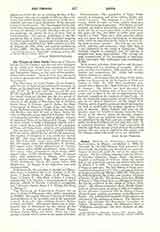

Sao Thiago de Cabo Verde, DIOCESE of (SANCTI JACOBI CAPITIS VIRIDIS), has the seat of its bishopric on the Island of S. Nicolau and comprises the Cape Verde Archipelago, which forms one civil province, and Portuguese Guinea, on the coast of Senegambia, which forms another. Each of these two provinces is under a governor who is appointed by the national Government.
THE PROVINCE OF CAPE VERDE (CABO VERDE), with the seat of the civil and military Government at Praia, on the Island of S. Thiago, lies between 14° 40′ and 17° 14′ N. latitude and between 22° 50′ and 25° 30′ longitude W. of Greenwich. It is made up of ten islands which are divided into the two groups of Barlavento and Sotavento. The Barlavento group consists of the islands of Boa-Vista, Sal, S. Nicolau, Santa Luzia, S. Vicente, and S. Antao; the Sotavento group, of Maio, S. Thiago, Fogo, and Brava. In the Barlavento group of islands there are two judicial districts, one with its seat at Santo Antao, the other at Mindello, on the Island of S. Vicente. The Sotavento group forms but one judicial district, the seat of which is at Praia, on the Island of S. Thiago. Each of these islands is under a municipal council (municipio), except Maio, which belongs to the municipio of Praia, and Santa Luzia, which is still uninhabited.
The province has a population of 142,000, of whom 4718 are whites, 50,033 blacks, and 87,249 mulattoes. The number of foreigners is very small, not exceeding 828. The areas and population of the islands are: Boa Vista, 236% square miles, 2691 inhabitants; Sal, 79% square miles, 640 inhabitants; S. Nicolau, 94% square miles, 10,462 inhabitants; S. Vicente, 75% square miles, 10,086 inhabitants; Santa Luzia, 15% square miles, uninhabited; Santo Ant-do, 302% square miles, 33,838 inhabitants; Maio, 42 square miles, 1895 inhabitants; S. Thiago, 419A square miles, 56,082 inhabitants; Foga, 204% square miles, 17,582 inhabitants; Brava, 21% square miles, 8970 inhabitants. S. Vicente is an important port and coaling station.
Ecclesiastically the province is divided as follows: Boa Vista, 2 parishes; Sal, 1; S. Nicolau, 2; S. Vicente, 1; Santo Antao, 6; Maio, 1; S. Thiago, 11; Fogo, 4; Brava, 2. Boa Vista contains 3 primary schools; Sal, 2; S. Nicolau, 1 lyceum-seminary and 6 primary schools; S. Vicente, 1 school of navigation, and 7 primary schools; Maio, 1; S. Thiago, 22; Fozo, 7; Brava, 6.
THE PROVINCE, OF PORTUGUESE GUINEA has an area of about 14,270 square miles, with a population of 300,000. Its capital, Bolama, is the seat of the only judicial district in the province, and of the municipal council. It has also three military districts, Bissau, Cacheu, and Geba. Portuguese Guinea has a vicar-general who is nominated by the bishop of the diocese. It contains six parishes: Bolama, Bissau, Cacheu, Farim, Buba, and Geba. There are a few primary schools, which, however, are poorly attended.
ETHNOGRAPHY.—The population of Cape Verde consists of European and native whites, blacks, and mixed (mesticos). The language is a dialect called crioulo, which is made up from various languages with Portuguese predominating. The people are half civilized, are mild in disposition, not inclined to hard work, and by no means provident, so that whenever the rains fail they are liable to suffer from great scarcity of food. They have little practical ability and are given to pleasure, particularly to dancing; balls, which are organized on the slightest pretext, being their favorite pastime. The arts are not cultivated; industry and commercewhat little there is—are exclusively in the hands of Europeans. The Catholic religion is professed, but its practice is mingled with many superstitions. The average annual frequentation of the sacraments is: baptisms, 4872; marriages, 534; confessions and communions, 36,000.
With respect to Guinea little can be said, its population being still in a condition of savagery. Its annual statistics are: baptisms, 330; marriages, 10; confessions and communions, 20. Arabic and various African dialects are spoken.
HISTORY.—It is known that the Cape Verde Archipelago was discovered by the Portuguese in 1460, and Guinea in 1445. In 1553 these territories were erected into a diocese by a Bull of Clement VII dated January 31. The diocese has been governed by prelates of great learning, some of them also of great virtue, and to them is due all the improvement that has been wrought in the condition of Cape Verde. It has no charitable organizations except a Confraternity of the Blessed Sacrament on the Island of S. Nicolau, which supports a primary school and supplies the lack of rural banks by lending capital at a low rate of interest. Mitra, Cabido, and some of the parishes enjoy the benefit of legacies made by benefactors of the diocese, which are liberally administered. There are no religious societies. The clergy are subsidized by the State and are exempt from the public burdens of military service, jury duty, etc. It is expected, however, that the legal separation of Church and State, already put in force at the national capital, will very soon be applied in this colony, and the changes which will result are as yet unknown.
JOSE ALVES MARTINS

